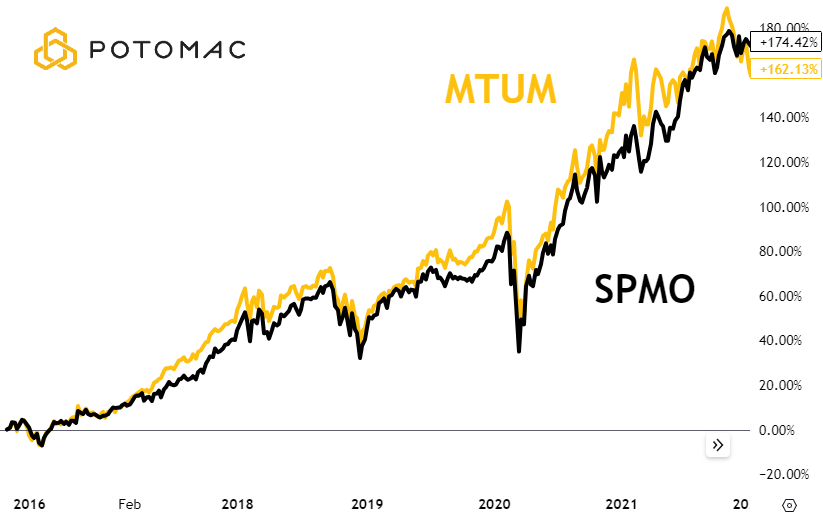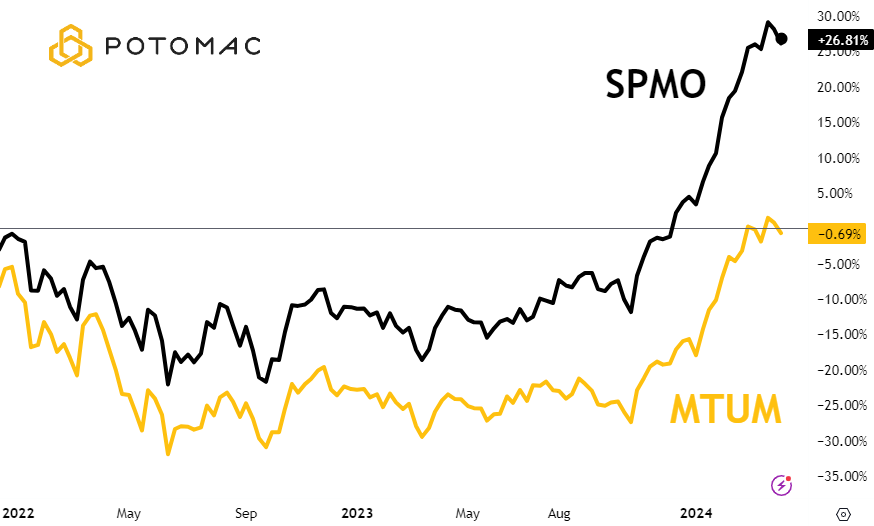
When you hear the word “momentum,” the first thing that may pop into your mind is an F1 Car, or a running back diving across the goal line. Regardless of your personal visualization of the word, the principle remains the same: no one wants to lose momentum.
When it comes to investing, momentum is the velocity of price change over time. Money managers may use momentum to identify the strongest performing securities with the hope that they continue to outperform in the future.
Two of the most widely followed ETFs using this methodology are the Invesco S&P 500 Momentum ETF (SPMO) and the iShares MSCI USA Momentum Factor ETF (MTUM).
On the surface these two may seem identical. They have similar descriptions and the same objective, but under the hood there are differences.
Momentum Calculation
Each fund must have a method for calculating momentum to determine which stocks to include.
This is likely to be the least differentiating element of the ETFs as many momentum calculations select similar securities.
For example, SPMO selects stocks using a 12-month rate of change adjusted for volatility – a simple and straightforward way to do it.
MTUM takes a more complex approach that blends a 6 and 12-month measure of momentum to create an average score that is then adjusted for volatility.
As of January 1, 2024, there was an 86% overlap between the top 100 stocks in the S&P 500 using a 12-month rate of change compared to a blend of 6-month and 12-month.
Given these facts, the selection methodology between the two ETFs will be similar and thus might not be the deciding factor for the allocator.
If not the selection method, what matters?
Fees are an important differentiator between many funds. However, there is only a two basis-point difference between the two momentum ETFs. This is not significant enough to cause a meaningful divergence in performance.
More frequent rebalancing will result in higher turnover inside the ETF. SPMO rebalances twice per year compared to quarterly for MTUM. If the allocator prefers less trading, MTUM has the edge.
The third consideration is the population of stocks from which to choose. Both ETFs trade large-cap U.S. stocks. The difference is that MTUM also includes mid-cap stocks.
Since a momentum strategy’s goal is to choose the best-performing stocks, we can expect most holdings have been stocks from the index that has outperformed. Since common inception on October 12, 2015, large caps (SPDR S&P 500 ETF Trust) have outperformed midcap stocks (SPDR Midcap Trust) by over 22%. At some point mid-caps may outperform giving MTUM the edge, but so far that has not happened for any prolonged period.
The fourth factor is the number of holdings. SPMO is more concentrated and will amplify the fund’s volatility, given that it holds 100 stocks compared to 125 for MTUM. Many allocators would consider holding fewer stocks to be negative because it lowers diversification.
All factors mentioned so far may cause a slight variance between the two funds, but it is likely that none of them would drive performance to be significantly different.
The Largest Differentiator
The largest differentiator is the allocation limit that MTUM enforces. At each rebalance period, the ETF imposes a 5% maximum allocation per stock. SPMO has a maximum of 9%.
At the time of this writing, the top allocation in SPMO accounts for 11.71% of the fund, while the largest weight in MTUM is only 5.85%.

The top 10 holdings in SPMO account for 55.89% of the fund vs. 43.05% for MTUM.
An allocator must ask themselves if they prefer concentration or diversification as this is likely to be what causes the funds to diverge over time.
Performance
Below is a chart from common inception through 12/31/2021. There was not much difference in performance during this six-year period.

Continuing from the start of 2022 Through Q1 2024 we can see the two began to diverge.

Lastly, below are both ETFs from common inception through Q1 2024.

The more concentrated SPMO has outperformed MTUM by ~65% as large-cap stocks, such as the Magnificent 7, have dominated the market since the October 2022 bottom. The higher concentration allowed these stocks to have a more significant impact on the portfolio.
Details Matter
Knowing the details of how a fund operates allows the allocator to make an informed decision.
Whether an advisor, retail investor, or fund manager, it is critical to know what we own and why we own it.
*All charts are from TradingView and FundVisualizer. They are for illustrative purposes only. Past performance is not indicative of future results.
Potomac Fund Management ("Company") is an SEC-registered investment adviser. SEC registration does not constitute an endorsement of the advisory firm by the SEC nor does it indicate that the advisory firm has attained a particular level of skill or ability. This information is prepared for general information only and should not be considered as individual investment advice nor as a solicitation to buy or offer to sell any securities. This material does not constitute any representation as to the suitability or appropriateness of any investment advisory program or security. Please visit our FULL DISCLOSURE page. The company does not make any representations or warranties as to the accuracy, timeliness, suitability, completeness, or relevance of any information prepared by any unaffiliated third party, whether linked to the Company website or incorporated herein, and takes no responsibility for any of this information. The views of the Company are subject to change and the Company is under no obligation to notify you of any changes. Different types of investments involve varying degrees of risk, and there can be no assurance that the future performance of any specific investment or investment strategy will be profitable or equal to any historical performance level.
PFM-615-20240426
